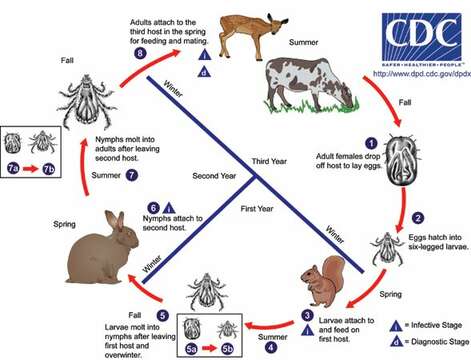Life cycle of three-host ixodid (hard) ticks.

Description:
Life cycle of three-host ixodid (hard) ticks.
The adult of a three-host ixodid (hard) tick is considered the diagnostic stage, as identification to the species level is best achieved with adults. Most ticks of public health importance are three-host ticks, including members of the genera Ixodes (Lyme borreliosis, babesiosis, human granulocytic ehrlichiosis), Amblyomma (tularemia, ehrlichiosis and Rocky Mountain spotted fever), Dermacentor (Rocky Mountain spotted fever, Colorado tick fever, tularemia, tick paralysis), and Rhipicephalus (Rocky Mountain spotted fever, boutonneuse fever).
Three-host ixodid ticks have a life cycle that usually spans three years, although some species can complete the cycle in just two years. After feeding, adult females drop off the third host to lay eggs (1), usually in the fall. Eggs hatch into six-legged larvae (2) and overwinter in the larval stage. In the spring, the larvae seek out and attach to the first host, usually a small rodent (3). Later in the summer, engorged larvae leave the first host (4) and molt into nymphs (5), usually in the fall. The ticks overwinter in this stage. During the following spring, the nymphs seek out and attach to the second host (6), usually another rodent (e.g., a mouse) or lagomorph (e.g., a rabbit). The nymphs feed on the second host and drop off later in the summer (7). Nymphs molt into adults (7a-7b) off the host in the late summer or fall, and overwinter in this stage. The next spring, adults seek out and attach to a third host, which is usually a larger herbivore (including cervids and bovids), carnivore, or human (8). The adults feed and mate on the third host during the summer. Females drop off the host in the fall to continue the cycle. Females may reattach and feed multiple times. The three hosts do not necessarily have to be different species, or even different individuals. Humans may serve as first, second or third hosts.
From Centers for Disease Control Parasites and Health website.
Included On The Following Pages:
- Life (creatures)
- Cellular (cellular organisms)
- Eukaryota (eukaryotes)
- Opisthokonta (opisthokonts)
- Metazoa (Animal)
- Bilateria
- Protostomia (protostomes)
- Ecdysozoa (ecdysozoans)
- Arthropoda (arthropods)
- Chelicerata (chelicerates)
- Arachnida (arachnids)
- Acari (mites)
- Parasitiformes (parasitiform)
- Ixodida (ticks)
- Ixodoidea
- Ixodidae (hard ticks)
- Amblyomma
- Amblyomma maculatum (Gulf Coast Tick)
- Panarthropoda
This image is not featured in any collections.
Source Information
- license
- cc-by-nc
- copyright
- Centers for Disease Control/Division of Parasitic Diseases and Malaria
- publisher
- Shapiro, Leo
- photographer
- Centers for Disease Control/Division of Parasitic Diseases and Malaria
- provider
- EOL Rapid Response Team
- original
- original media file
- visit source
- partner site
- EOL staff
- ID


